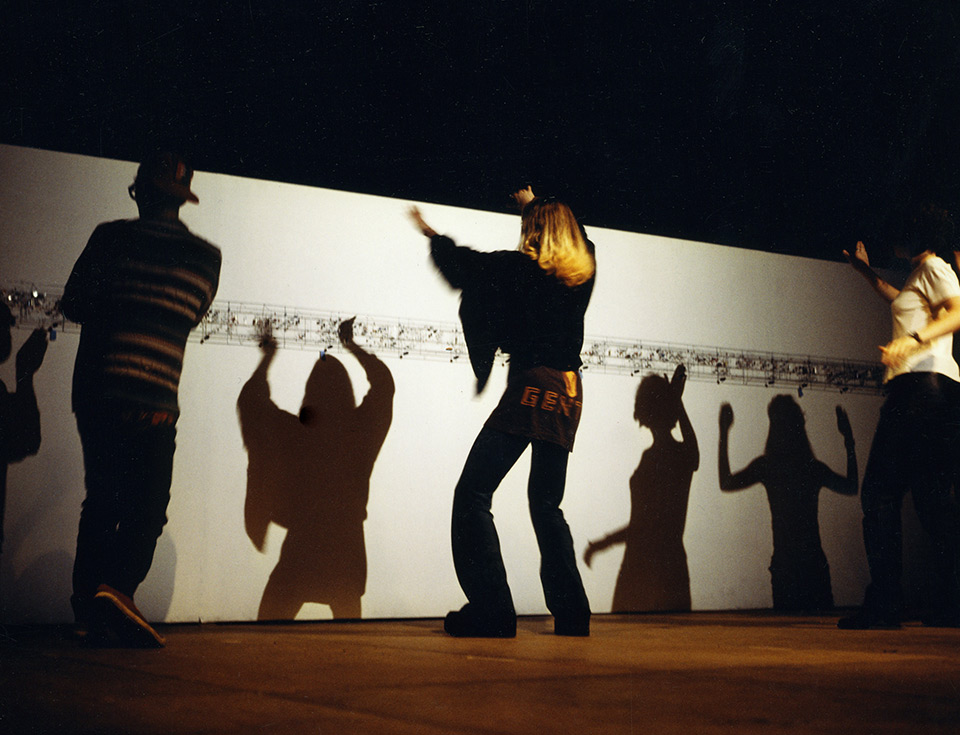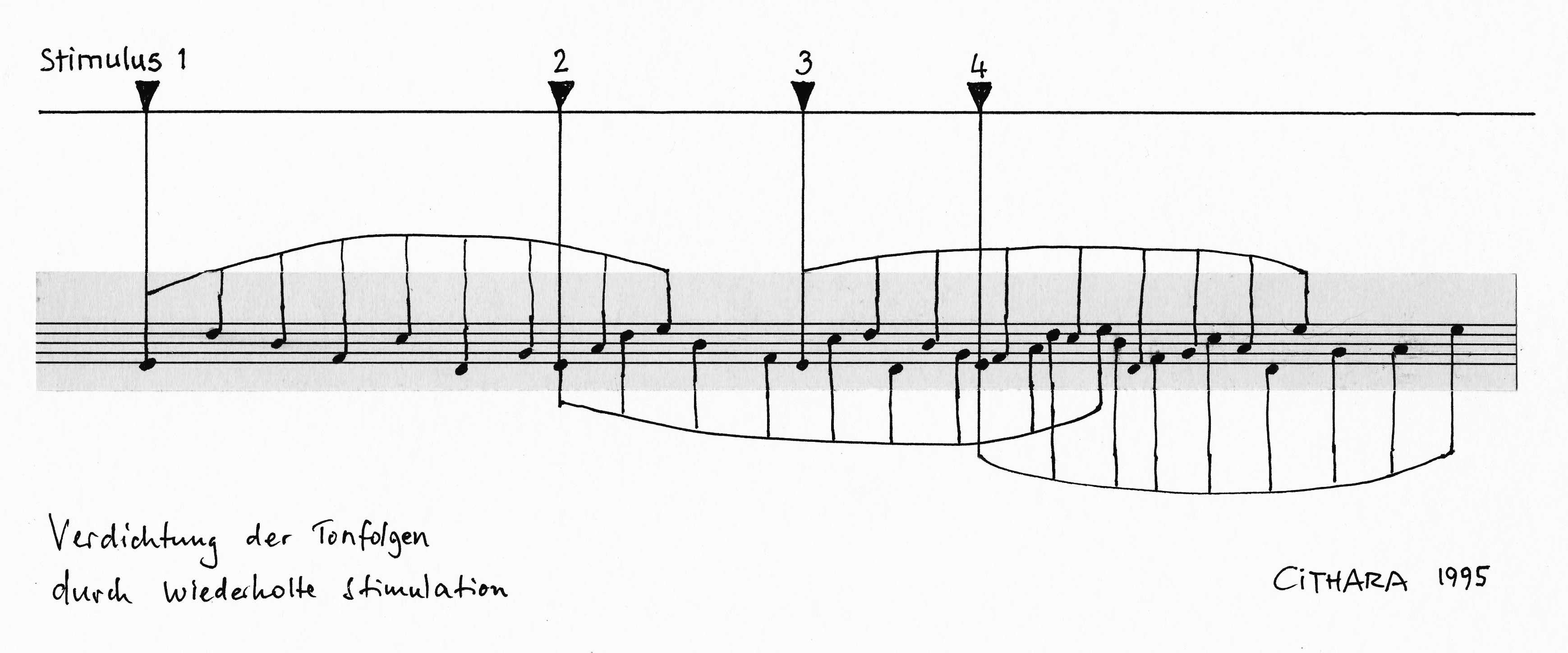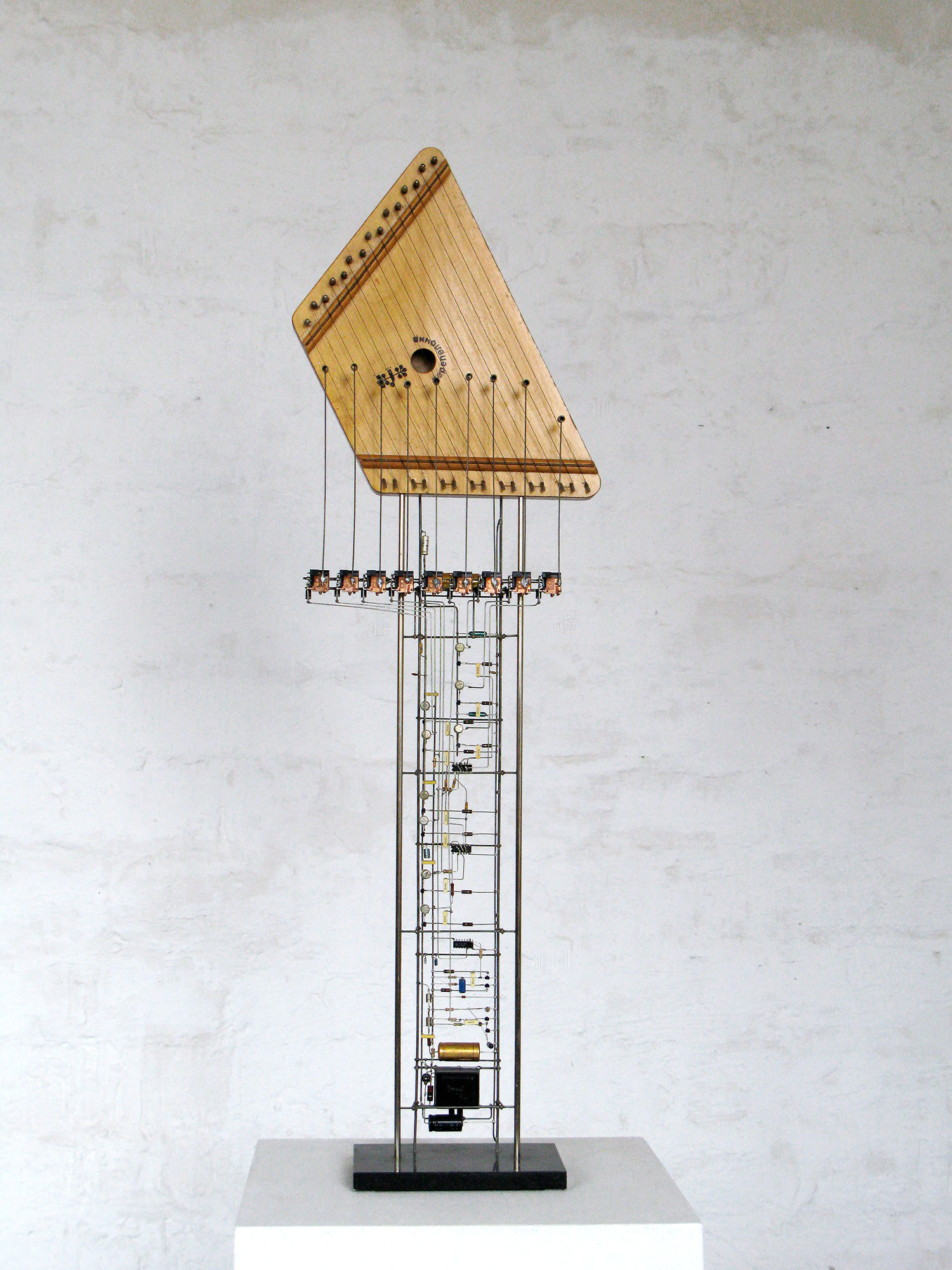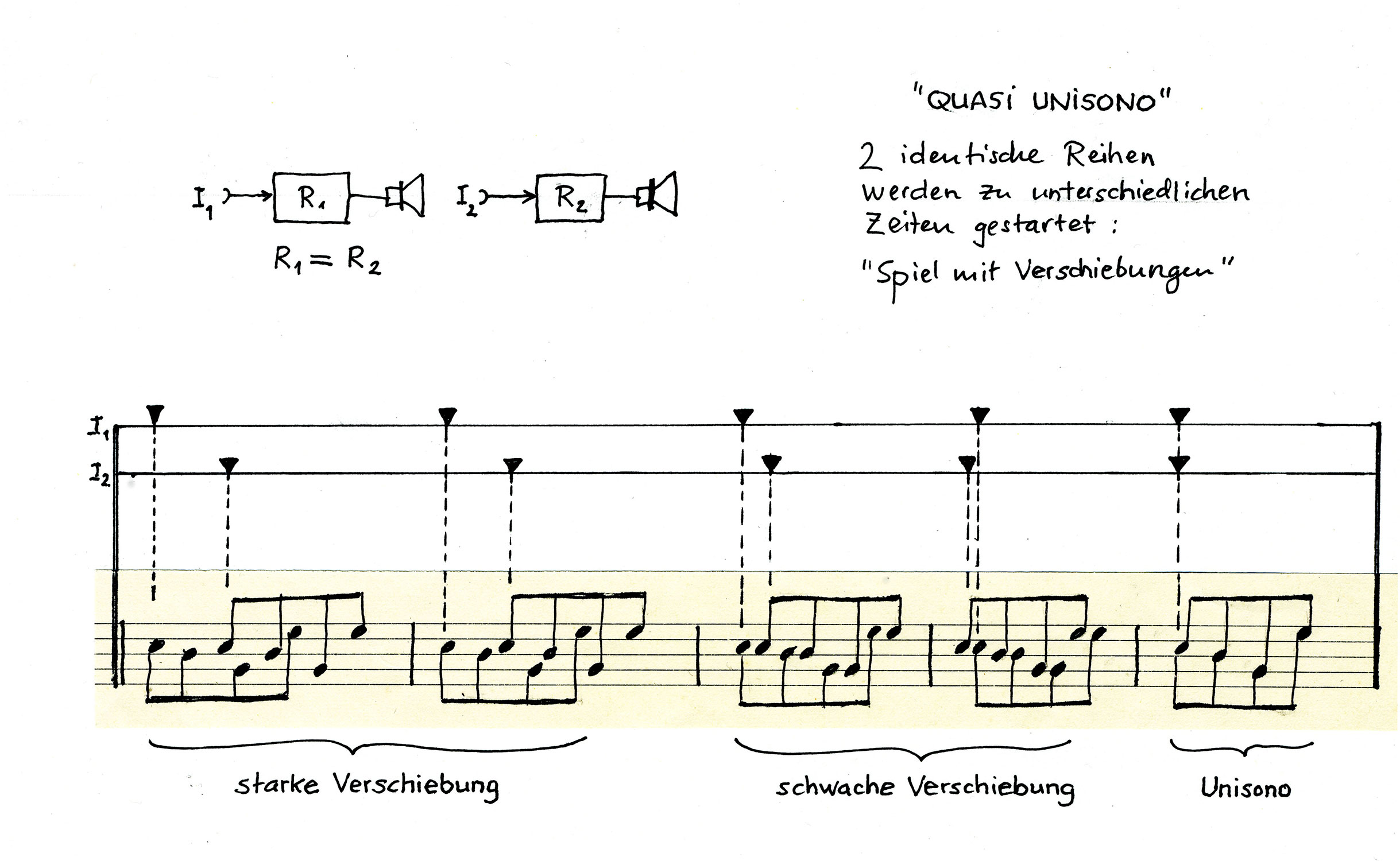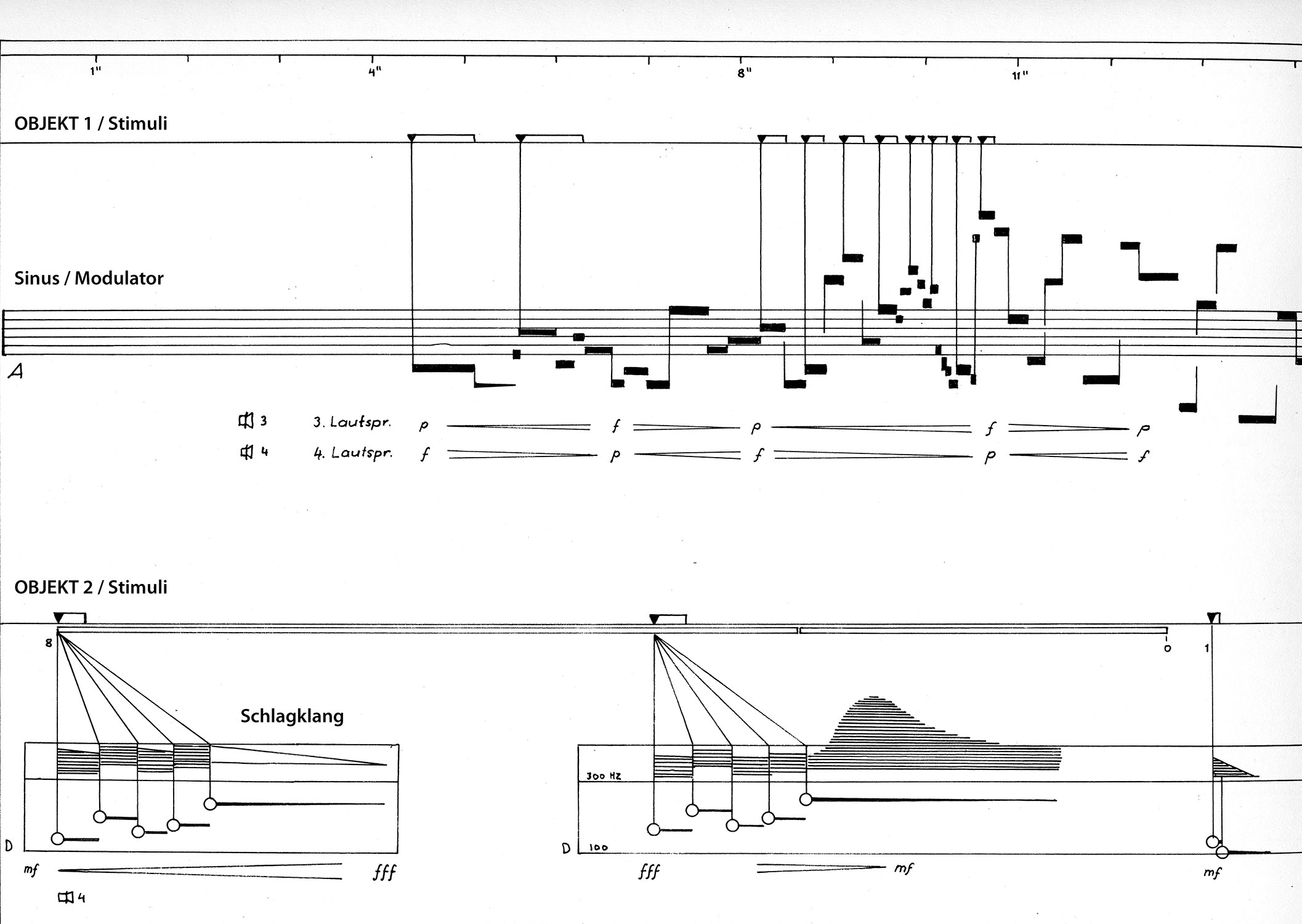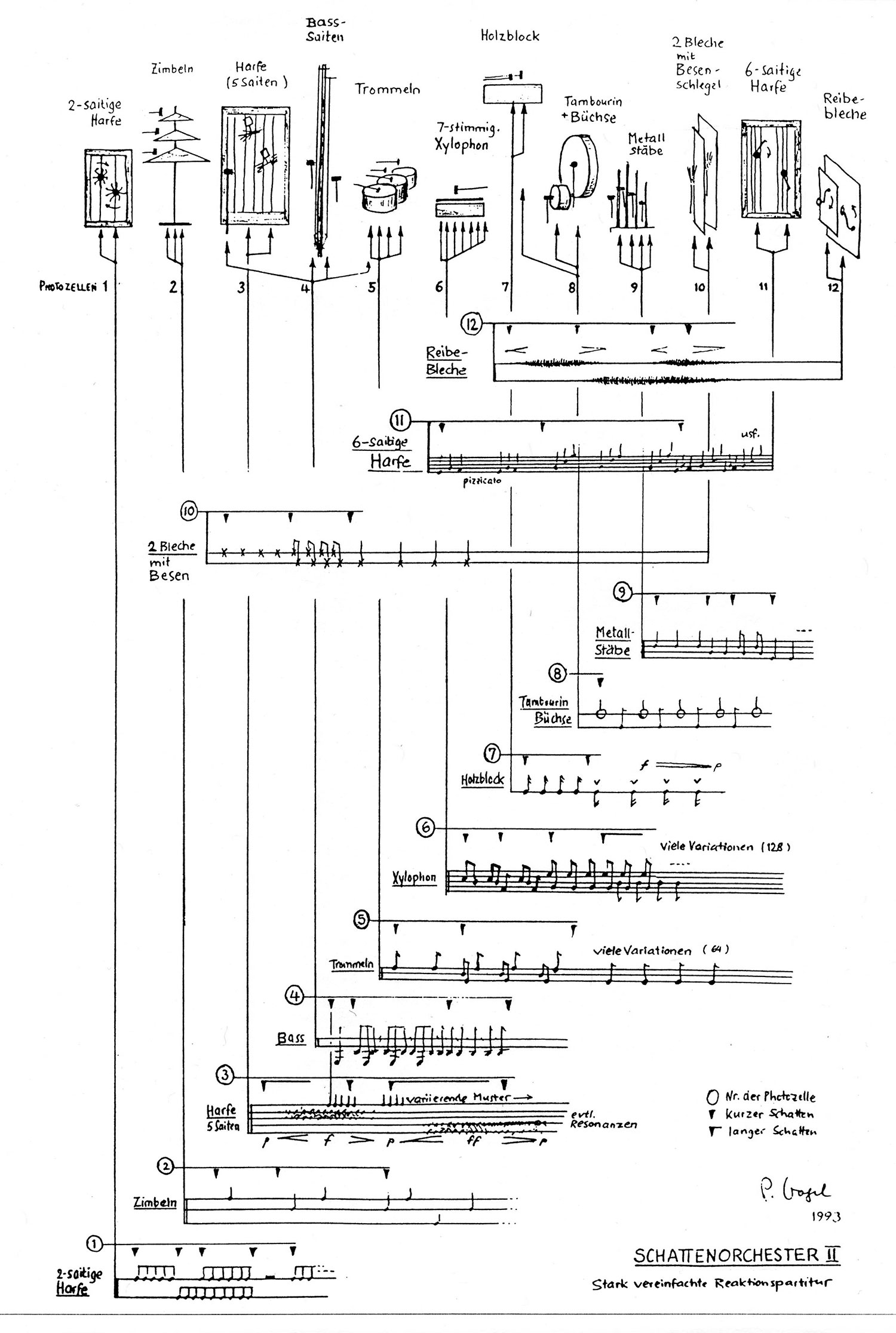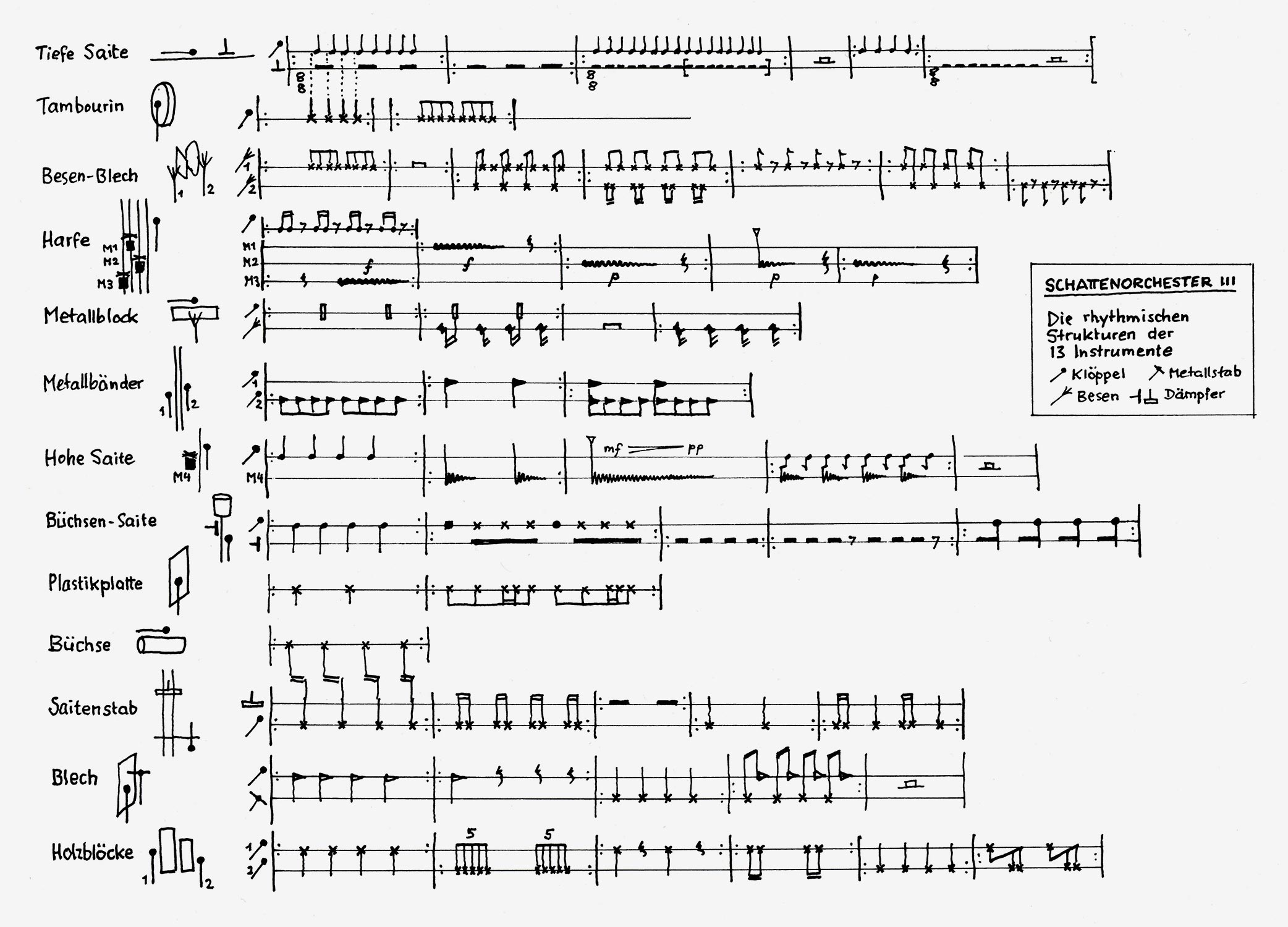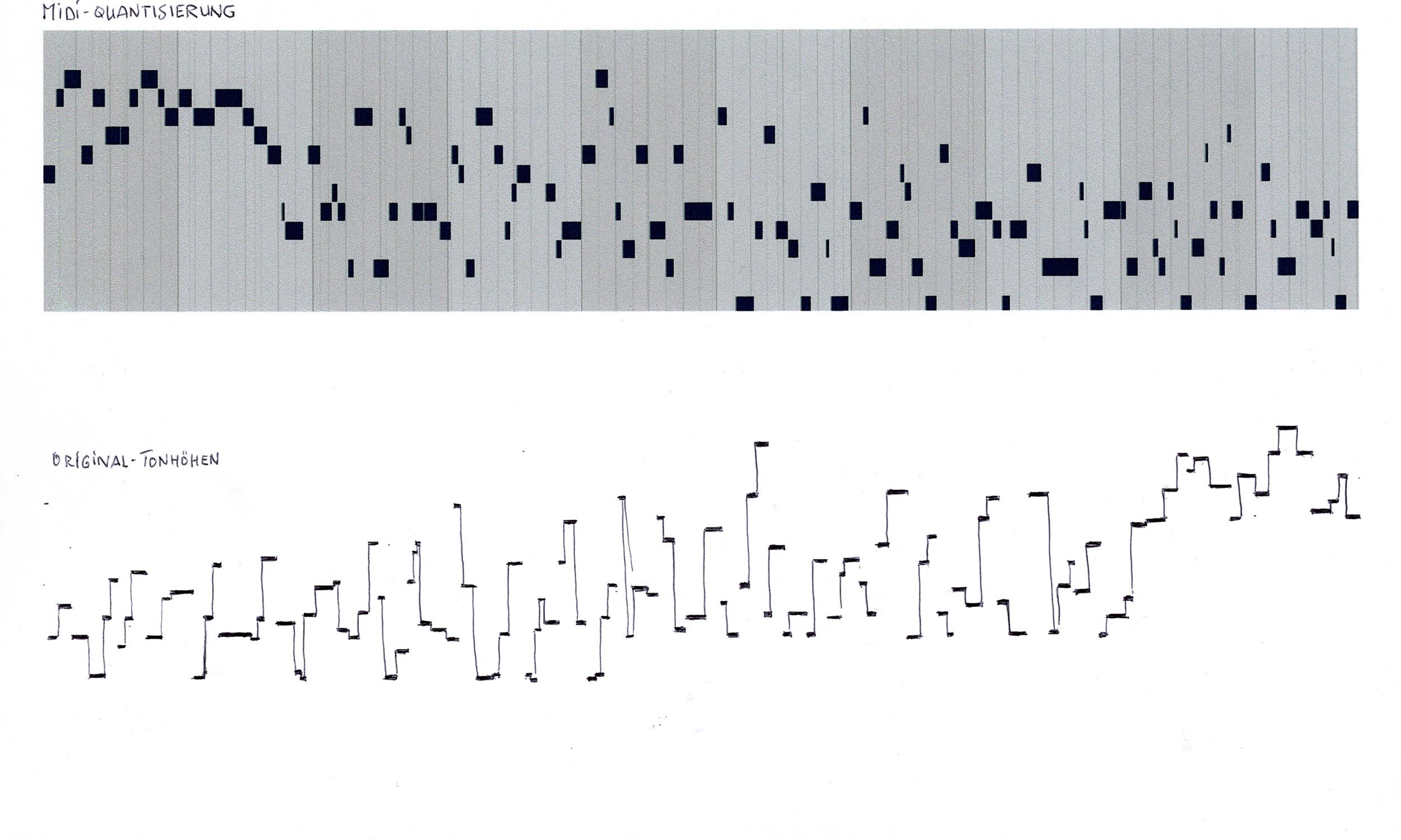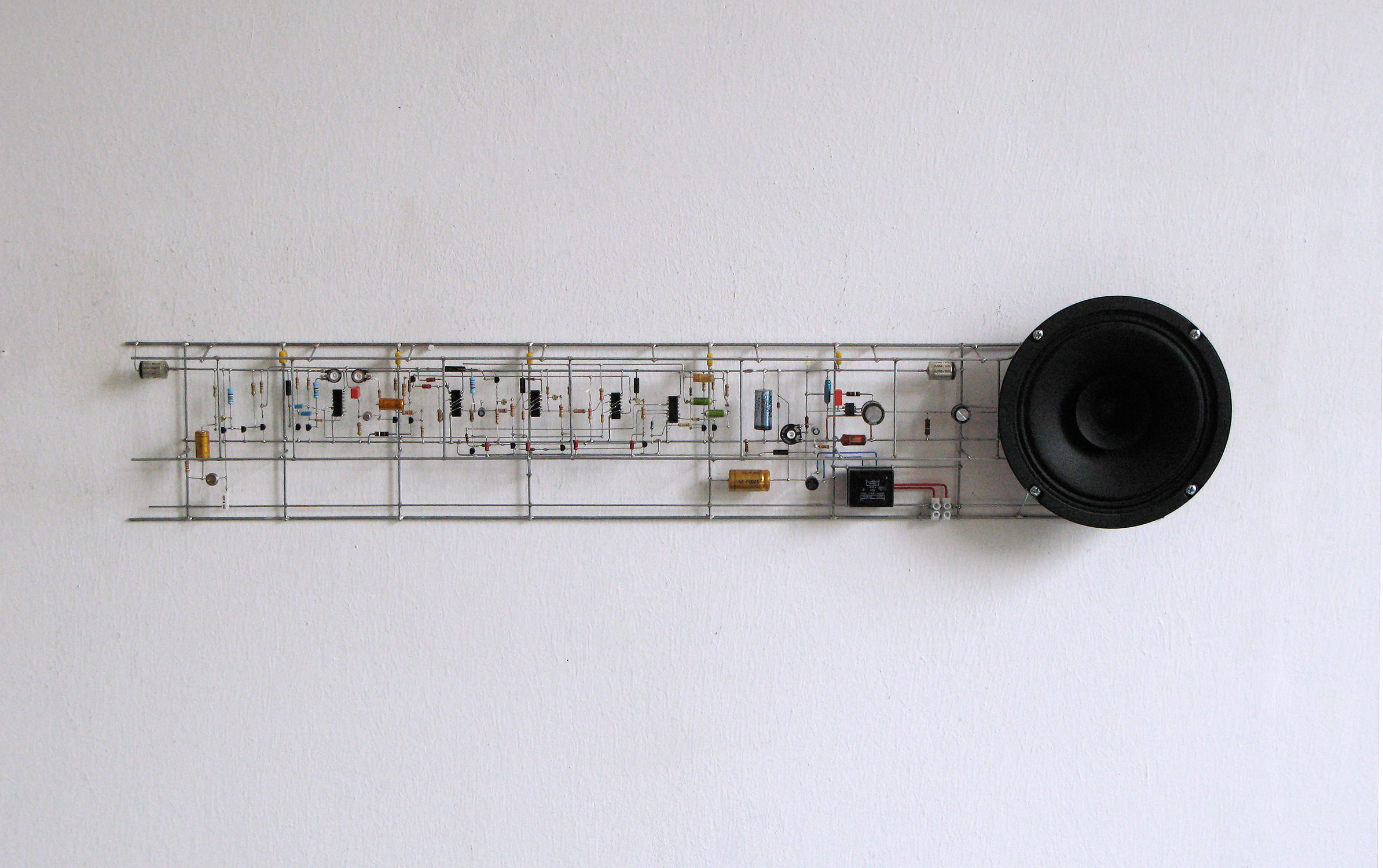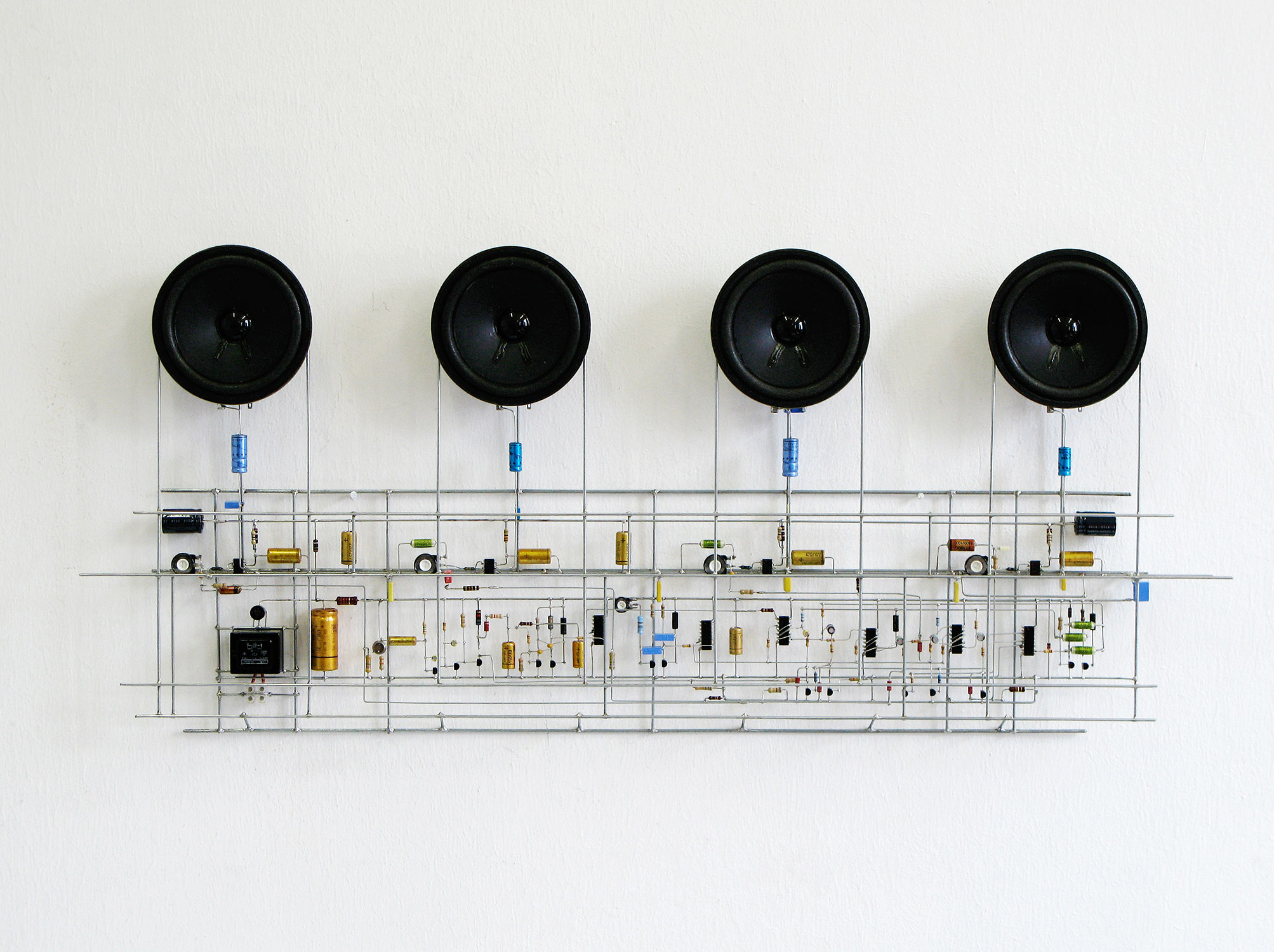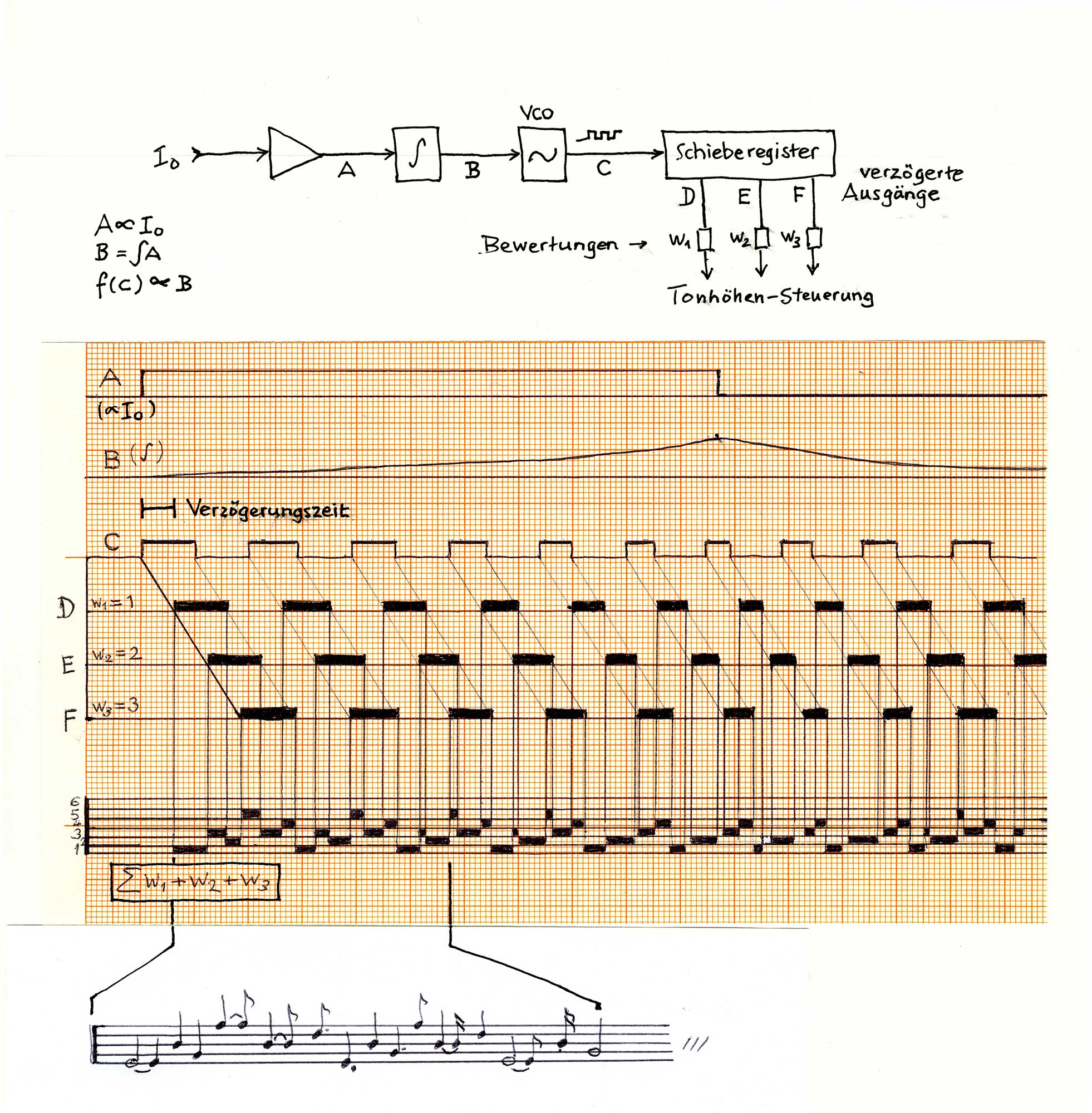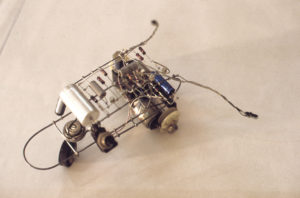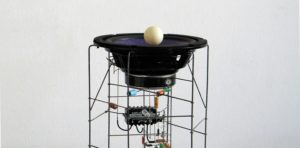What does a shadow sound like? Can shadows even make music? Peter Vogel put together entire sound orchestras. At the Donaueschingen Festival of 1994, a renowned international festival for New Music, one could see, hear—and play one of them, because Vogel’s sculptures have to be activated in order to produce sound.
They are not self-sufficient machines, but instead require an observer who becomes an actor, a player.
The shadows play music when one slips out of the role of the passive observer (jumping over one’s own shadow, one might say) and begins to play with one’s shadow and to use it as an instrument in order to activate the instruments of the shadow orchestra. The interface between the shadow play and the shadow music is a photocell. It reacts to shadows and activates the musical structures and potentials inherent in the sculptures. This basic principle is characteristic of Peter Vogel’s sound objects—regardless of whether the music originates from self-constructed synthetic instruments (as in the shadow orchestras) or whether it sounds out as electronic music from loudspeakers, which is typical of a majority of Vogel’s objects. Among them, the various sound walls play a central role: large-scale sound sculptures that he began developing at the end of the 1970s into a major work group in his artistic-musical oeuvre.
These sound walls are “materialized musical scores” (Vogel). This characteristic does not stand for the external, visible appearance of the objects. And yet their very appearance allows associations with the arrangement of musical notation: the elongated horizontals of the thin, chrome-plated iron wires with their short, vertical stabilizing elements function like an abstract system of note and bar lines, into which the tiny electronic parts (capacitors, transistors, resistors, diodes, photocells, and integrated circuits) are incorporated—as if they were meticulously composed musical notations.
Nevertheless, the term “materialized score” in Peter Vogel’s work instead aims at the inner structure of a sound wall (or even a shadow orchestra): at its interactive musical conception. Precisely determined musical material is prescribed in each work, and can be activated and played directly by the observer of the object.
When the photocells are stimulated, a precise sonorous figure is triggered and heard over the loudspeakers. These sound figures are primarily based on repetitive, rhythmically structured sequences. Each has its own rhythm and meter. The different, completely determined sound figures can be called up variably, and observers can improvise or compose with them.
Vogel originally began with atonal-sounding objects, in which the sound structures shift when the sequences overlap acoustically: on the basis of a sophisticated serial principle of tone sequences, which he began working on for his sound sculptures starting in the 1970s. An important catalyst for this was his Musikalisches-kybernetisches Environment at the Donaueschingen Festival of 1975 (fig. 1). Two years later, the first dance performance took place at the Music Biennial Zagreb. From then on, the encounter of sound sculpture and dance would become a formative element in Vogel’s oeuvre. While his objects were initially primarily kinetic sculptures, in which Vogel was particularly concerned with neuro-cybernetic system theory and experiments, his works subsequently developed into sophisticated sound instruments. While, in his early objects, sounds mainly function as acoustic parameters for the clarification of time structures, sounds increasingly began to interest him in musical terms as well. Although experiments with time structures remained an essential moment of his objects, Vogel continuously expanded the musical parameters of his objects. A significant impulse in this process was his fascination with and involvement in minimal music, which had a decisive influence on his work: the objects—for example, Minimal Structure (1982) or Minimal Music, Piece for 6 players (1983)—as well as the sound walls—for example, Kleine Minimal Music Klangwand (1987) or Minimal Music Klangwand 88 (1988). His later “Klangwand” (sound wall) works, such as Rhythmic Sounds (1996), which Vogel designed as a “techno-klangwand,” were also based on his intensive involvement with minimal music (fig. 3).
Peter Vogel created the music for his sound sculptures exclusively with the electronic parts present in the object itself, and abstained from using sampling techniques, synthesizers, or computers. His compositional work consists of determining the progression and modification opportunities offered by the sound material itself
(fig. 4+5). At the same time, the composition is only completed through action and interaction with viewers/players/dancers. They have numerous variation and combination possibilities: the poly-rhythmically structured sound material defined in pitches and timbres is designed by the player with respect to volume, forcing or letting the sound figures disappear, and experimenting with different combinations and variations of the sound sequences. Due to multiple reaction possibilities, aleatoric and improvisational moments dominate as a creative principle. The result is a complex process of interplay between actor and sound sculpture, between the perception of musical structures and of movement and space. The artistic and musical result is in any case unique and unrepeatable.
The interactive design of his objects also distinguishes the special significance of Peter Vogel’s works within the international sound art scene. Since the art recipients have to become active, the sculptures necessitate the action of a player and fellow-player. Without an acting counterpart, the work of art exists merely as a shadow of itself, as a mute, optical-aesthetic object in the sense of conventional visual art. Only the play with light and shadows makes the sculptures speak. Sculpture and action constitute the interdisciplinary aesthetic field of adventure and experience. Thus, the art recipients become producers, performers, and composers, as well as active co-designers of the artwork.
This interaction—the interdependencies between the actions of the player and the reactions of the object—formed Peter Vogel’s actual aesthetic process, by analogy to the aesthetics of “action,” “happening,” and “performance.” The “movement structures” of the recipient always trigger the “reaction structures” of the object. With the term “movement structure,” Vogel apprehended the interaction of those parameters that form the basis for the respective stimulation of the photocells: the tempo, duration, rhythm, pauses, and frequency of the impulses. Such movement structures are different for each actor and depend on his or her attitude toward the object, which can be guided by factors such as curiosity, accident, creativity, reflection, fiddling around, or trying things out.
At the same time, the objects have various recording modes for the respective movement parameters, because each sound object has a specific sound-generating matrix that results from the formation of the reaction structures on which it is based. These basic patterns are not immediately recognizable for the observing actors, and are not easily revealed to them, despite their playful interaction with the object. Since the audible results always turn out differently—even if the basis of the formation of reactions with an object are always the same. The intrinsic structures of an object’s reactions to the actors’ stimuli remain concealed behind the perceivable sound events, but they constitute the character and extensive compositional potential of the respective object.
In this respect, Peter Vogel’s objects can be classified into various groups, each of which is based on different patterns of constructing the processing of impulses. The most frequent are the three methods that Vogel called the series formation principle, the integral principal, and the building block principle. In the series formation principle, all the parameters of the actor’s movement structure can have an influence on the reaction structure of the object, whereas in the integral principle, the duration of frequency of the impulses influences how the object reacts. With the building block principle, the individual reaction pattern can not be influenced at all, but there is an additive interaction of several sensors, whose actions are superimposed and permuted (especially with objects such as sound walls and shadow orchestras).
For Peter Vogel, the most important method from a musical perspective was the sequencing principle, because it offers the most sensitive way of reacting to impulses of movement: here it is possible for actors to intervene extensively in the fine structures of the tone sequences and sounds. One can change time structures, intervals, pitches, and timbres in such a way that the tonal result extends into areas of microtonality and microrhythm.
The serial structures are obtained by delaying the triggering impulses of the players several times.
The delayed impulses overlay the impulses initially triggered. The sum of the overlaps controls the respective pitches (fig. 6). For example, three delays result in four series of impulses, which generate a total of twenty-five different possible pitches. If these, in turn, are distributed over the range of an octave, microtonal intervals are created (as for example with the sound object Zwei ineinander versteckte Tonfolgen (fig. 7). A similar situation arises in the area of tone durations. This principle of series formation is the basis of many of Vogel’s sound objects. His creative design possibilities (for the creator of the objects) are very diverse, mainly depending on how many delays he chose and how he organized the coding of the groups of delayed impulses.
Based on this principle of series formation, Vogel, in turn, developed different variations. The principle of fixed series, in which the stimuli always trigger the same sequence of notes, is relatively straightforward. However, repeated stimuli can cause this sequence to overlap with itself with a time delay, resulting in different tone sequences. In the sound object Cithara, for example, all the strings are struck one time by a single shadow,
and the sequence of pitches is always the same for each stimulus. If, however, another stimulus is triggered during the course of this sequence of notes, this results in a compression of the tone sequences, in which a completely different sequence of notes is generated by superimposition (fig. 8) By means of precise stimulation, the player can create a variety of different tonal figures, because the temporally shifted overlapping of a series with itself can generate as many new tone sequences as desired. In the case of Cithara, however, the variety of tones is limited to the existing mechanically producible tones of the instrument. This is a decisive difference to objects that work with electronically generated sounds, because, in this case, the sequence principle always results in the formation of new pitches. When playing with superimpositions and time differences, which is characteristic with objects like Cithara (fig. 9), the time differences between the first and the subsequent stimuli play the decisive creative role. Rhythm and the frequency of the stimuli are also included, but are secondary
when viewed as a whole.
An exceptional case of the play with the shifting of fixed series can be found in the sound object Quasi Unisono,
in which two identical tone series can be started with a time delay. As soon as the durations of the respective stimuli are not exactly the same, either double tones or completely new tone series are created as a result of their superimposition (fig. 10). Ultimately, this work shows that it is very difficult to generate a genuine unisono,
since the simultaneous movements required for this cannot be performed as precisely as would be necessary.
Another variation of the sequence principle is found in objects with circular structure, in which a specific sequence of tones is repeated for a certain period of time. If new impulses occur during the repetitions,
these in turn generate overlapping, which, along with the original structure, lead to new repetitive patterns.
In the case of the sound wall Rekurs (fig. 11), for example, the sound figure is triggered by the players’ respective rhythm of movement (fig. 12). Insofar as they continue to set new impulses during the repetitions, a new sound file is added and altered by superimposition, which is repeated in turn. This results in the generation of a tonal layering of the previous and the most recent sequences.
The combination of the series formation principle with circular structures, as is characteristic for Rekurs, also refers to the general combinability of the various patterns of reaction formation. The application of the circular principle can, for example, be combined with all other procedures, right up to those of Vogel’s works that are characterized by random principles. In the same way, this principle of series formation can be combined with other working methods. One particularly remarkable case in this context is the use of the integral principle and series formation principle in the sound sculpture Perpetuum, one of Vogel’s final works.
In contrast to the series formation principle, in the integral principle, an object does not react to all the parameters of the players’ movements, but only to the duration or frequency of impulses. Here, the endurance of the actors (in an interactive context) literally becomes part the object’s reaction mode, so to speak. The duration or tempo of the shading stimuli (but not parameters such as rhythm) lead to changes in its reaction structure, for instance, with respect to timbre, volume, tempo, additional notes, or a switch from staccato to legato. Vogel perceived this way of reacting in analogy to the behavior of neurons that are frequently stimulated (habituation). In Vogel’s work Perpetuum (fig. 13), too, only the duration of the shading of the photocell causes the object to react;
other parameters, such as speed or rhythm, have no effect on the sound structure. At the same time, however,
the sound generation of the object that is initiated in this way is underpinned by the principle of series formation (fig. 14), so that the impulses give rise to very complex reactions, which are conveyed via four loudspeakers, and are also constantly changing. The influence of the player is transformed into a system that is not comprehensible for him/her on the level of sensorial experience. Complementary to this, for the actor/creator, the extraordinary attraction of this sound object is precisely the fact that—based on a totally determined system—a completely atonal and random sounding microtonality that opens up any number of possibilities is generated.
Vogel took his cue here from the concepts of chaos theory and interpreted the way this object reacts as a striking example of how the smallest time shifts produce large effects. From an aesthetic point of view,
such sound-generating procedures characterize Peter Vogel’s deeply musical way of thinking, and, at the same time, the techniques and strategies of the compositional structures concealed in the objects make it clear that his works should not only be situated within the contexts of kinetic art or sound installations, but can also be thought of within the context of New Music.
SHADOW MUSIC. THE SOUND SCULPTURES OF PETER VOGEL
by Eckhard John.
